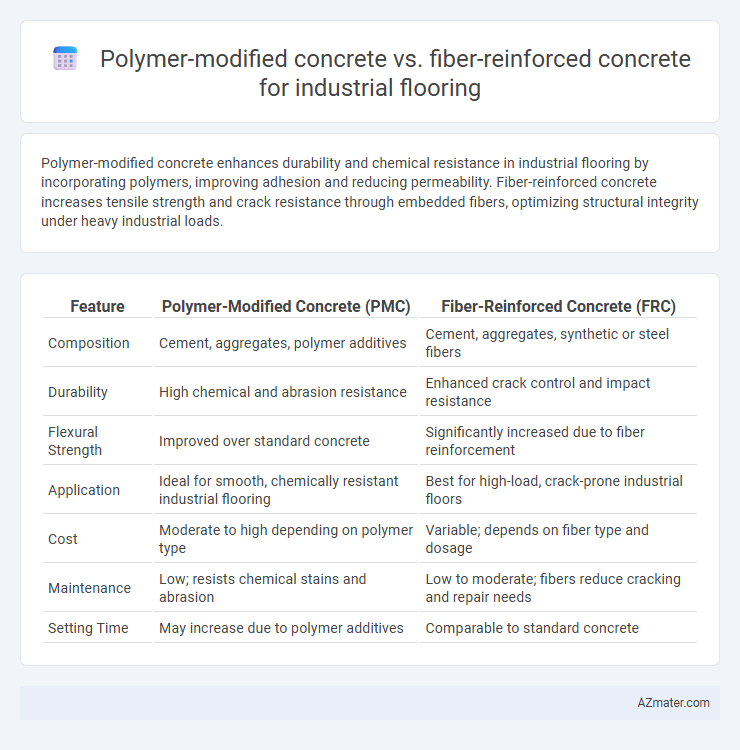Polymer-modified concrete enhances durability and chemical resistance in industrial flooring by incorporating polymers, improving adhesion and reducing permeability. Fiber-reinforced concrete increases tensile strength and crack resistance through embedded fibers, optimizing structural integrity under heavy industrial loads.
Table of Comparison
| Feature | Polymer-Modified Concrete (PMC) | Fiber-Reinforced Concrete (FRC) |
|---|---|---|
| Composition | Cement, aggregates, polymer additives | Cement, aggregates, synthetic or steel fibers |
| Durability | High chemical and abrasion resistance | Enhanced crack control and impact resistance |
| Flexural Strength | Improved over standard concrete | Significantly increased due to fiber reinforcement |
| Application | Ideal for smooth, chemically resistant industrial flooring | Best for high-load, crack-prone industrial floors |
| Cost | Moderate to high depending on polymer type | Variable; depends on fiber type and dosage |
| Maintenance | Low; resists chemical stains and abrasion | Low to moderate; fibers reduce cracking and repair needs |
| Setting Time | May increase due to polymer additives | Comparable to standard concrete |
Introduction to Industrial Flooring Solutions
Polymer-modified concrete enhances industrial flooring by improving adhesion, chemical resistance, and durability, making it ideal for heavy-duty environments exposed to harsh chemicals and mechanical wear. Fiber-reinforced concrete incorporates synthetic or steel fibers to increase tensile strength, crack resistance, and impact resilience, providing a robust solution for industrial floors subjected to dynamic loads and thermal stresses. Both materials offer tailored benefits for industrial flooring, optimizing performance and longevity in demanding operational settings.
Overview of Polymer-Modified Concrete
Polymer-modified concrete (PMC) integrates polymers such as styrene-butadiene or acrylics into traditional concrete mixes, significantly enhancing adhesion, flexibility, and chemical resistance, making it ideal for heavy-duty industrial flooring. This modification improves the concrete's durability against mechanical stress, thermal cycling, and exposure to oils or solvents common in industrial environments. PMC offers superior surface bonding and reduced permeability compared to fiber-reinforced concrete, resulting in longer-lasting floors with reduced maintenance requirements.
Overview of Fiber-Reinforced Concrete
Fiber-reinforced concrete (FRC) enhances industrial flooring by incorporating diverse fibers such as steel, glass, or synthetic materials to improve tensile strength, durability, and crack resistance. This composite material provides superior impact resistance and reduces shrinkage compared to conventional concrete, making it ideal for heavy-duty applications in warehouses and manufacturing plants. FRC's ability to control micro-cracking and improve load distribution extends the lifespan and performance of industrial floors under high traffic and mechanical stress.
Material Composition and Properties
Polymer-modified concrete for industrial flooring integrates synthetic polymers such as styrene-butadiene or acrylics into the cement matrix, enhancing adhesion, flexibility, and chemical resistance while reducing permeability. Fiber-reinforced concrete incorporates discrete fibers like steel, glass, or polypropylene to improve tensile strength, crack resistance, and impact absorption without significantly altering workability. Material properties differ as polymer modification primarily increases durability against chemicals and abrasion, whereas fiber reinforcement enhances mechanical performance and controls shrinkage-related cracking under heavy industrial loads.
Installation Methods and Application Techniques
Polymer-modified concrete (PMC) installation involves mixing polymer resins with cement to enhance adhesion, flexibility, and chemical resistance, typically applied using standard pouring and troweling methods suitable for heavy industrial loads. Fiber-reinforced concrete (FRC) incorporates synthetic or steel fibers directly into the mix to improve tensile strength and crack resistance, requiring careful dispersion of fibers before placing and finishing with power trowels or screeds for uniform fiber distribution. Both materials demand precise surface preparation and curing protocols to maximize durability in industrial flooring applications, though PMC often allows faster setting times and stronger bonding to substrates compared to FRC.
Mechanical Performance Under Heavy Loads
Polymer-modified concrete exhibits enhanced tensile strength and improved adhesion, making it highly resistant to cracking and deformation under heavy industrial loads. Fiber-reinforced concrete offers superior impact resistance and increased toughness due to the distribution of fibers, which effectively control shrinkage cracks and improve load-bearing capacity. For industrial flooring subjected to continuous heavy traffic, fiber-reinforced concrete typically provides better durability and mechanical performance in dynamic loading scenarios.
Durability and Resistance to Chemical Exposure
Polymer-modified concrete enhances industrial flooring durability by improving tensile strength and reducing permeability, making it highly resistant to chemical exposure such as oils, acids, and solvents. Fiber-reinforced concrete increases toughness and crack resistance through the integration of synthetic or steel fibers, providing superior impact resistance and better performance under heavy mechanical stresses. Both materials extend the service life of industrial floors, but polymer modifications offer greater chemical resistance while fiber reinforcement excels in controlling shrinkage and structural integrity.
Crack Control and Shrinkage Comparison
Polymer-modified concrete enhances crack control and reduces shrinkage through improved adhesion and flexibility, making it highly effective for industrial flooring subjected to heavy loads. Fiber-reinforced concrete incorporates synthetic or steel fibers that distribute tensile stresses, significantly minimizing crack propagation and controlling shrinkage-induced microcracks. While both methods improve durability, polymer-modified concrete offers superior resistance to chemical attack and moisture, whereas fiber-reinforced concrete excels in mechanical toughness and impact resistance.
Cost Analysis and Lifecycle Considerations
Polymer-modified concrete (PMC) typically incurs higher initial costs due to the addition of polymers enhancing adhesion and durability, while fiber-reinforced concrete (FRC) may offer cost savings by reducing the need for steel reinforcement and improving crack resistance. Lifecycle cost analysis shows PMC often extends flooring lifespan through better chemical resistance and reduced maintenance, whereas FRC provides enhanced toughness and impact resistance, potentially lowering repair frequency. Selecting between PMC and FRC depends on specific industrial flooring requirements, balancing upfront investment with long-term performance and maintenance expenses.
Best Use Cases and Industry Recommendations
Polymer-modified concrete excels in industrial flooring applications requiring enhanced chemical resistance, reduced permeability, and improved adhesion, making it ideal for environments exposed to aggressive chemicals and high moisture. Fiber-reinforced concrete is preferred for heavy-duty industrial floors that demand superior tensile strength, crack control, and impact resistance, such as warehouses and manufacturing plants with heavy machinery. Industry recommendations suggest using polymer modification for corrosion-prone areas and fibers for structural durability and load-bearing capacity to optimize floor longevity and performance.

Infographic: Polymer-modified concrete vs Fiber-reinforced concrete for Industrial flooring
 azmater.com
azmater.com